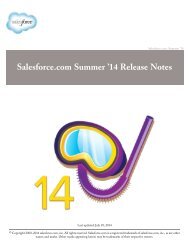salesforce_security_impl_guide
salesforce_security_impl_guide
salesforce_security_impl_guide
You also want an ePaper? Increase the reach of your titles
YUMPU automatically turns print PDFs into web optimized ePapers that Google loves.
Securing and Sharing Data<br />
Assigning Page Layouts in the Original Profile User Interface<br />
4. Select a record type from the Available Record Types list and add it to the Selected Record Types list to make it available to users<br />
with that profile.<br />
Master is a system-generated record type that's used when a record has no custom record type associated with it. When Master<br />
is assigned, users can't set a record type to a record, such as during record creation. All other record types are custom record types.<br />
5. From the Default drop-down list, choose a default record type.<br />
If your organization uses person accounts, this setting also controls which account fields display in the Quick Create area of<br />
the accounts home page.<br />
6. If your organization uses person accounts, set additional options for the default record types for both person accounts and business<br />
accounts. These settings are used when defaults are needed for both kinds of accounts, such as when converting leads.<br />
• From the Business Account Default Record Type drop-down list, choose a default record type for business<br />
accounts.<br />
• From the Person Account Default Record Type , choose a default record type for person accounts.<br />
7. Click Save.<br />
Options in the Record Type Settings section are blank wherever no record types exist. For example, if you have two record types for<br />
opportunities but no record types for accounts, the Edit link only displays for opportunities. In this example, the picklist values and<br />
default value for the master are available in all accounts.<br />
Note: If your organization uses person accounts, you can view the record type defaults for business accounts and person accounts<br />
in the Account Record Type Settings section of the profile detail page. Also, clicking Edit in that section is an alternative way of<br />
opening the page where you set record type defaults for accounts.<br />
Assigning Page Layouts in the Original Profile User Interface<br />
1. From Setup, click Manage Users > Profiles.<br />
2. Select a profile.<br />
3. Click View Assignment next to any tab name in the Page Layouts section.<br />
4. Click Edit Assignment.<br />
5. Use the table to specify the page layout for each profile. The table displays the page layout<br />
assignments for each profile. If your organization uses record types, a matrix displays a page<br />
layout selector for each profile and record type. Selected page layout assignments are<br />
highlighted. Page layout assignments you change are italicized until you save your changes.<br />
6. If necessary, select another page layout from the Page Layout To Use drop-down list<br />
and repeat the previous step for the new page layout.<br />
7. Click Save.<br />
EDITIONS<br />
Available in:<br />
• Enterprise<br />
• Performance<br />
• Unlimited<br />
• Developer<br />
USER PERMISSIONS<br />
To assign page layouts in<br />
profiles:<br />
• “Manage Profiles and<br />
Permission Sets”<br />
23






